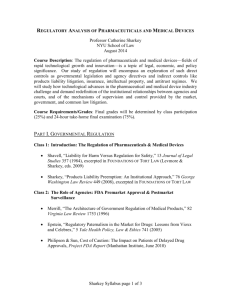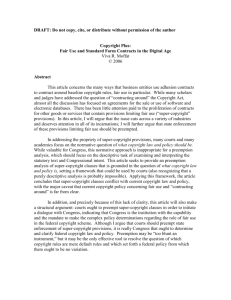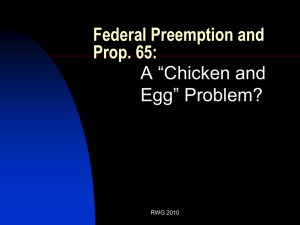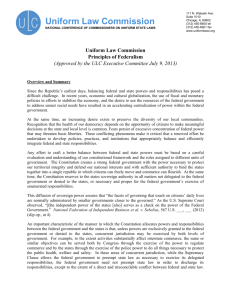Temporal Isolation with Preemption Delay Accounting
advertisement
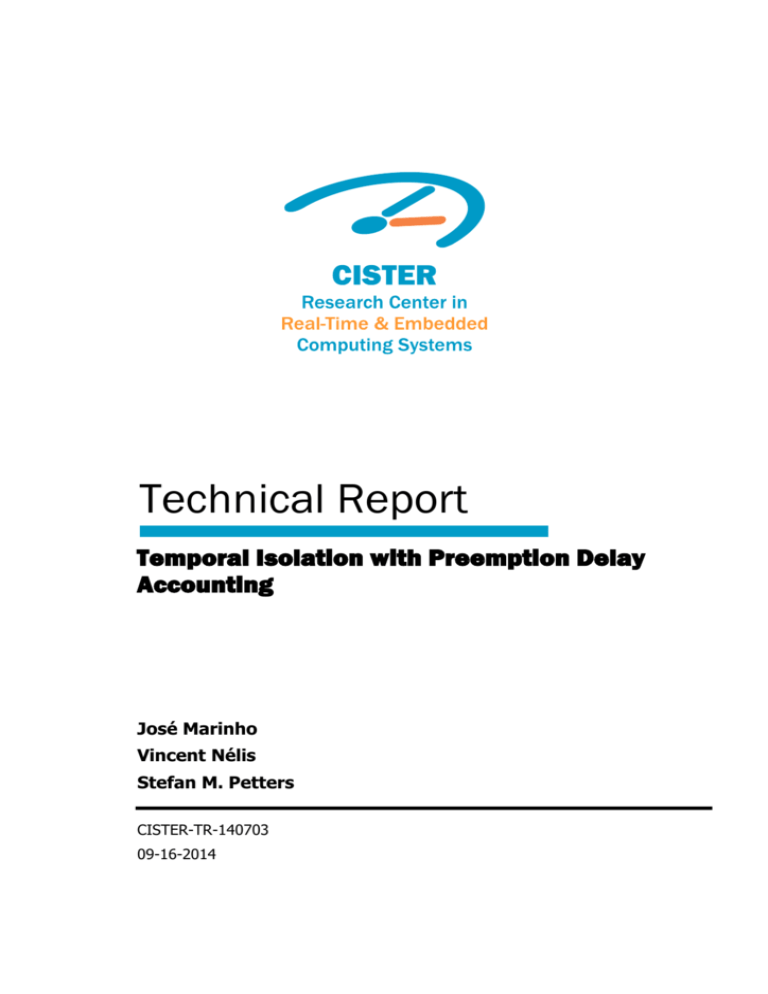
Technical Report
Temporal Isolation with Preemption Delay
Accounting
José Marinho
Vincent Nélis
Stefan M. Petters
CISTER-TR-140703
09-16-2014
Technical Report CISTER-TR-140703
Temporal Isolation with Preemption Delay Accounting
Temporal Isolation with Preemption Delay Accounting
José Marinho, Vincent Nélis, Stefan M. Petters
CISTER Research Center
Polytechnic Institute of Porto (ISEP-IPP)
Rua Dr. António Bernardino de Almeida, 431
4200-072 Porto
Portugal
Tel.: +351.22.8340509, Fax: +351.22.8340509
E-mail: jmssm@isep.ipp.pt, nelis@isep.ipp.pt, smp@isep.ipp.pt
http://www.cister.isep.ipp.pt
Abstract
© CISTER Research Center
www.cister.isep.ipp.pt
1
Temporal Isolation with Preemption Delay
Accounting
José Marinho∗
Vincent Nélis∗
∗ CISTER/INESC-TEC,
Stefan M. Petters∗
Polytechnic Institute of Porto, Portugal
Email: {jmsm,nelis,smp}@isep.ipp.pt
Abstract—Reservation systems are generally employed to enforce temporal isolation between applications. In the real-time
context the corresponding temporal isolation requires not only
the consideration of the direct interference due to execution of
higher priority tasks, but also the indirect cost of e.g. cacherelated preemption delay. The accounting of this in a server-based
implementation of temporal isolation poses special challenges,
in particular when misbehaving in the form of overruns and
violation of the minimum inter-arrival time of an application
are to be covered. We present a novel approach to extend the
fault coverage and reduce the pessimism when compared to the
state of the art. Furthermore we demonstrate that the extra
implementation of the introduced mechanisms over the state of
the art can be very low on complexity.
I. I NTRODUCTION
In today’s technology, the vast majority of the processors
that are manufactured are not deployed in desktop or servers,
but instead are built in embedded devices. Besides having
specific functional requirements many functionalities (called
tasks hereafter) deployed in such systems are subject to stringent timing constraints; in particular their executions have to
complete by a deadline associated to each task. Tasks exposing
such timing requirements are usually called “real-time” tasks.
A violation of a task deadline might bring about the same
complications as a functional failure in the task execution, so
correctness of a real-time task depends on both the logical
results of its computations and the time at which these results
are produced.
Before a safety-critical system can be deployed and marketed, a certification authority must validate that all the safetyrelated norms are met. All the components comprising that
system (the software, the hardware, and the interfaces) are
scrutinized to ensure conformance to safety standards. Timing
guarantees must be derived at design time and consequently
enforced during run-time for the system to be certified. These
timing guarantees are obtained through timing and schedulability analysis techniques, which are typically more accurate
and simpler when spatial and temporal isolation between
tasks is provided. This is because timing analysis techniques
must thoroughly examine every shared resource and identify
a worst-case interference scenario in which the analyzed
task incurs the maximum delay before accessing the shared
resource[s]. Without a proper isolation between the tasks: First,
the number of interference scenarios to be explored may be
out of proportion, hence compelling the analysis techniques
to introduce an undesired pessimism into the computation by
over-approximating these scenarios. Secondly, having a high
number of possible interference scenarios naturally increases
the probability of encountering a “pathological” case, where
the delay incurred by the analyzed task in that particular sce-
nario is far higher than in the average case. Since the analysis
tools must capture the worst-case scenario, this pathological
case will be retained and used in higher-level analyses (like
schedulability analyses) which are built upon the results of
timing analyses (thus propagating the pessimism all the way
up to system-level analyses).
A first step in the certification process is to categorize
each component (software and hardware) by its level of
criticality and assign a unitary safety integrity level1 (SIL)
to all components. When integrated in the same platform
the components of different SILs share low-level hardware
resources such as cores, cache subsystems, communication
buses, main memory, etc. To provide the required degree of
“sufficient independence” between components of different
SILs, Industry and Academy have been seeking solutions for
many years to (1) render the components of a same SIL as
independent and isolated as possible from the components with
different SILs and (2) upper-bound the residual impact that
components of different SILs may have on each other after
the segregation step, with the primary objective of certifying
each subset of components at its own SIL.
Within this work, the focus is set on temporal isolation. We
consider the scenario where symmetric isolation is enforced,
i.e. where tasks do not impact each other irrespective of their
individual SIL. A standard implementation of the symmetric
temporal isolation is by the usage of servers [1], [2]. These
servers provide a certain share of the processing resource
called budget, which is supplied to a task in a recurrent
fashion.
While the general concepts of servers have been well
explored, the use of implicitly shared resources, like caches
is still an open issue for server-based systems. When a task
executing in a server is preempted by a higher priority task,
it loses at least partially its set of useful memory blocks in
the caches (working set) and other shared resources. This
loss of working set leads to an additional execution time
requirement on resumption of execution, which either needs
to be accounted for in the sizing of the budgets of individual
tasks, or treated through online mechanisms.
Contribution of the paper: Besides easing timing analyses,
schedulability analyses, and the certification process, the main
objective of temporal isolation via servers is also to isolate
applications from other temporally misbehaving applications
and their corresponding effects. Within this work we discuss
analysis and online mechanisms which prove suitable to pro1 A Safety Integrity Level (SIL) is defined as a relative level of risk-reduction
provided by a safety function, or to specify a target level of risk reduction.
In simple terms, a SIL is a measurement of performance required for a safety
instrumented function.
vide temporal isolation addressing two forms of misbehavior
from a task: (a) Execution over-run, i.e. a job requesting a
workload greater than the WCET assumed at design time,
and (b) job released at a faster rate than assumed at design
time. A simple solution to ensure the temporal isolation in
systems only subject to miss-behaviors of type (a) is achieved
by setting the budgets of each server equal to the worstcase execution time (WCET) of the task plus an upper bound
on the maximum preemption delay that any job might suffer
during its execution. We provide an alternate solution for such
systems: an online mechanism that augments the cpu-budget
associated to a task whenever it resumes its execution (on
returning from preemption). Then, in order to maintain the
temporal isolation in systems faced with miss-behaviors of
type (a) and (b) we provide a further online mechanism that
transfers budgets from the server of the preempting task to the
server of the preempted task at each preemption occurrence.
For this type of systems there exists no solution in the literature
providing full temporal isolation.
Organization of the paper: In the next section, we provide
an overview of related work followed by a description of
our system model in Section III. In this we also give a very
brief review of the reservation-based framework which is used
during the work discussion. The options for preemption delay
accounting mechanisms in the reservation based system are
discussed in Section IV leading to the presentation of our
budget augmentation approach in Section V. Section VI is
devoted to the discussion of the violation of the minimum
arrival assumption. An experimental evaluation followed by
conclusions and indication of future work finalizes the document.
II. R ELATED W ORK
Reservation-based systems are quite a mature topic in realtime literature. Sporadic servers [1], [3] are proposed in
real-time literature to ensure temporal isolation in fixed task
priority systems. Each server reserves a budget for the task
execution. A task can only execute if the server budget is not
depleted. This ensures that the interference generated by a task
in the schedule cannot exceed what is dictated by its server
parameters and servers are the scheduled entities.
Solutions for temporal isolation in Earliest Deadline First
(EDF) also exist employing the sporadic server concept,
namely constant bandwidth server (CBS) [1] and Rate Based
Earliest Deadline First (RBED) [2]. Each server has an absolute deadline associated to it which acts as the server priority.
On top of the temporal isolation properties these frameworks
also employ budget passing mechanisms which enhance the
average-case response time of tasks in the system without
jeopardizing the temporal guarantees [4], [5].
The previously employed execution models assume that the
interference between workload occurs solely on the CPU. As it
turns out, if other architectural subsystems are shared in the execution platform which present some state with non-negligible
state transition times (e.g. caches), interference between task
will be created (commonly referred to as preemption delay).
The maximum preemption delay any task may endure may still
be integrated into the task’s budget2 , this solution is shown in
2 we assign one server per task, the task and server term is used interchangeably in this document
this paper to be subject to heavy pessimism. When minimum
inter-arrival times of tasks cannot be relied upon (i.e. tasks
release jobs at a faster rate than computed at design time),
the previously mentioned frameworks fail to ensure temporal
isolation between concurrent tasks in the system.
Systems with non-negligible cache related preemption delay
(CRPD) have been a subject of wide study. Several methods
have been proposed that provide an off-line estimation based
on static analysis for this inter-task interference value. Lee et
al. [6] presented one of the earliest contributions on CRPD
estimation for instruction-caches. The authors introduced the
concept of useful cache blocks, which describe memory blocks
potentially stored in the cache at a given program point and
that are potentially reused in the later program execution. They
assume that the CRPD incurred by a task after the preemption
by another task is constant throughout a basic block. By
considering for the maximum quantity of information a task
may have in the cache at every basic block and the maximum
quantity of information that any preempting task can evict,
they have devised a formulation for the computation of the
maximum preemption delay a task may suffer. Several works
followed, either by reducing the complexity of the schedulability analysis or by enhancing the definition of useful cache
blocks [7], [8], [9].
Embedded in all the stated frameworks are schedulability
tests. Scheduling analysis for [6] is based on response time
analysis (RTA); Ju et al. [10] have provided a demand bound
function-based procedure suitable for EDF schedulability with
preemption delay awareness. The general approach of computing the CRPD is similar to Lee’s.
In order to ensure temporal isolation cache partitioning may
be employed [11]. This technique has the disadvantage of
decreasing the usable cache area available to each task, and as
a consequence impacting its performance. Other architectural
subsystems exist (e.g. TLB, dynamic branch predictors, etc.)
which cannot be partitioned in order to remove the interference
source between tasks. Recently an approach has been proposed
where, when a task starts to execute it stores onto the main
memory all the contents of the cache lines it might potentially
use [12]. After the preempting task terminates its execution
it loads back from memory all the memory blocks that it
has stored in the cache at its release. This indeed ensures
temporal isolation among different applications but has several
drawbacks. It unnecessarily moves all the memory blocks
to main memory which reside in cache lines it might use
even if the actual execution does not access them. This
mechanism significantly increases memory traffic which may
be troublesome in multicore partitioned scheduling due to
increased contention on the shared memory bus. In comparison
our approach only passes budgets between servers and hence
this budget is only used if it is required. As a last limitation
of [12] it cannot cope with scenarios where a given task does
not respect the minimum inter-arrival contract part.
As a last resort non-preemptive scheduling policies may be
employed to avoid CRPD. By nature, these are not subject to
any preemption delay overhead. Even though fully preemptive
fixed task priority and non-preemptive fixed task priority are
incomparable with respect to schedulability (i.e. one does not
dominate the other), the later presents lower schedulability
capabilities [13].
III. S YSTEM M ODEL
We model the workload by a task set T = {τ1 , . . . , τn }
composed of n tasks, where each task τi is characterized by
the three-tuple hCi , Di , Ti i with the following interpretation:
τi generates a potentially infinite sequence of jobs, with the
first job released at any time during the system execution and
subsequent jobs released at least Ti time units apart. Each
job released by τi must execute for at most Ci time units
within Di time units from its release. Hence, the parameter
Ci is referred to as the “worst-case execution time”, Di is
the relative deadline of the task and Ti is its minimum interrelease time (often called, its period). In this work we only
focus on task sets where Di 6 Ti . These three parameters Ci ,
Di and Ti represent an agreement between the task and the
system. If the system can complete the execution of all the
jobs by their respective deadline then the task set is said to be
“schedulable”. Considering that the tasks are scheduled by a
fixed-priority scheduling algorithm, e.g. Deadline-Monotonic,
we assume that tasks are indexed by decreasing order of
priority, i.e., τ1 has the highest priority and τn the lowest one.
In this work, we use the notion of “contract”, where each
task has a contract with the system. From the point of view
of a task, this contract states that as long as the task respect
its parameters Ci and Ti , its temporal deadline Di will be
met. However, tasks may not always respect their contract.
We say that a task τi “behaves” if it does not require more
CPU resources than indicated by its parameters Ci and Ti .
Otherwise, if any job of τi comes to request more than Ci
time units to complete, or if τi releases two consecutive jobs
in a time interval < Ti time units, then τi is said to be
“misbehaving”. The other party – the system – is assumed to
never violate its contracts with any task. The system associates
to each task τi a sporadic server Si defined by the two-tuple
hBi , Tis i. The parameter Bi encodes the execution budget that
Si provides to τi in any time window of length Tis . This budget
is consumed as task τi executes and a task can only execute
if its budget is not depleted. We shall resort to the function
Bi (t) to denote the remaining budget in the server Si at every
time instant t.
A sporadic server is, at any time instant, in either one of
the two following states:
active when there is pending workload from task τi and Bi (t) >
0;
idle when there is no pending workload from task τi or
Bi (t) = 0.
The sporadic server budget replenishment mechanics can be
described succinctly by the protocol formulated with the two
following rules:
• When the server transits to the Active state at a time t1 ,
a recharging event is set to occur at time instant t1 + Tis ;
• when Si transits to the idle state at a time t2 , the replenishment amount corresponding to the last recharging time
is set to the amount of capacity consumed by Si in the
interval [t1, t2).
At the start of the system (t = 0) Si is idle and Bi (t) = Ci .
We assume Tis = Ti for the sake of simplicity and hence,
Ti is used throughout the document as a synonym for Tis .
From this point onward, we assume that all the task
deadlines are met at run-time as long as every job of each
task τi executes within the execution budget granted by Si
and respects its timing parameters Ci and Ti . The framework
proposed here ensures that, though any task τi can misbehave
by violating its stated parameters, the other tasks in the system
will never miss their deadlines as long as they behave. Note
that we assume throughout the document that each server has
only a single task associated to it. The server and task terms
are used interchangeably in the remainder of the document.
IV. C OMPARISON B ETWEEN P REEMPTION D ELAY
ACCOUNTING A PPROACHES
In a reservation-based system, as previously stated, each
task τi can only execute as long as Bi (t) is greater than 0. If
every job is guaranteed to meet its deadlines, then at each time
t where task τi releases a job, it must hold that Bi (t) is greater
than or equal to Ci plus the maximum preemption delay that
the job may be subject to during its execution. We denote by
δj,i the maximum interference that a task τj may induce in
the execution time of task τi by preempting it. This maximum
interference can be computed by using methods such as the
ones presented in [7], [14], [15].
Given all these δj,i values, we present below a naive solution
to compute the budget Bi of each task τi ∈ T . If we assume
that task τj releases its jobs exactly Tj time units apart, then
the maximum number of jobs that τj can release in an interval
of time of length t is given by
t
def
nj (t) =
(1)
Tj
Therefore, during the worst-case response time of a task τi
denoted by Ri , there are at most nj (Ri ) jobs of task τj ,
j < i, that can potentially preempt τi . Since each of these
preemptions imply an interference of at most δj,i time units
on the execution of τi , a straightforward way to compute the
budget Bi assigned to each task τi to meet all its deadlines is
def
Bi = Ci +
i−1
X
nj (Ri ) × δj,i
(2)
j=1
For the budget assignment policy defined in Equation (2),
Equation (3) gives an upper-bound PDmax
bgt (t) on the total CPU
time that is reserved in any time interval [0, t] to account for
all the preemption delays.
n
i−1
X
X
def
ni (t) ×
PDmax
=
nj (Ri ) × δj,i
bgt (t)
i=2
=
n
X
i=2
j=1
ni (t) ×
n
X
nj (Ri ) × δj,i
(3)
j=1
as ∀ j > i it holds that δj,i = 0.
It is worth noticing that Equation (2) assigns the budget of
task τi by looking at how many times τi might get preempted
during the execution of each of its jobs and how much each
such preemption may cost. That is, this budget assignment
policy implicitly considers the problem from the point of view
of the preempted task.
An alternative approach to analyze the maximum preemption delay that a task can incur consists in considering the
problem from the point of view of the preempting task. An
example of such an approach has been presented by Stachulat
et al [9]. The authors defined the multi-set Mj,i (t) as the set of
all costs δj,k that tasks τj may induce in the execution requirements of all the tasks τk with a priority between that of τj and
τi , in a time window of length t. A multi-set is a generalisation
of the concept of “set” where the elements may be replicated
(i.e. a multi-set may be for example {x, x, x, y, y} whereas a
regular set consists of a collection of elements such that no
element is equal to any other in the same set). The multi-set
Mj,i (t) is formally defined at any time t as follow:
def
nj (t)
nk (t) nj (Rk )
Mj,i (t) = ]i−1
]
]
δ
]g=1
δj,i
(4)
j,k
m=1
k=j+1
`=1
The operator ] denotes the union over multi-sets. Let us look
at a brief example to differentiate between the multi-set union
and the set union. For the multi-set union we have {x, y} ]
{x, y} = {x, x, y, y} whereas for the set union the outcome
is {x, y} ∪ {x, y} = {x, y}.
Each set Mj,i (t) enables the construction of the function
∆j,i (t), denoting the maximum preemption delay caused by
jobs from task τj on task τi in any time window of length t.
X
j=1 e∈Mj,i (t)
j=1 k=2
n
X
6
nk (t) ×
n
X
from(3)
nj (Rk ) × δj,k
j=1
k=2
PDmax
bgt (t)
6
Pn P
Pn
Lemma 2:
j=1
e∈Mj,i (t) e >
j=1 ∆j,i (t)
Proof: On the one hand, one can observe from Equation (4) that the number of elements in the multiset Mj,i (t) is
given by
i−1
X
#Mj,i (t) =
nk (t) × nj (Rk ) + nj (t)
(9)
k=j+1
and since nj (Rk ) > 1, ∀j, k ∈ [1, n], it holds that
i−1
X
#Mj,i (t) > nj (t) +
nk (t)
(10)
k=j+1
qj,i (t)
def
∆j,i (t) =
Proof: From Equation (8), we know that
n X
n
X
X
e
6
nk (t) × nj (Rk ) × δj,k
n
X
`
max(Mj,i (t))
(5)
On the other hand, since when j = k we have
min(nk (t), nj (t)) = min(nj (t), nj (t)) = nj (t)
`=1
and thus this Equation (6) can be rewritten as:
where
def
qj,i (t) =
i−1
X
min(nk (t), nj (t))
(6)
qj,i (t)
= nj (t) +
k=j
and the function max(Mj,i (t)) returns the `th highest
def
value in the set Mj,i (t) – the equation ∆j,i (t) =
Pqj,i (t) `
`=1 max(Mj,i (t)) thus represents the sum of the qi,j (t)
highest values in Mj,i (t).
We show below that, considering the preemption delay
from the perspective of the preempting task is always less
pessimistic than considering the preemption delay from the
point of view of the preempted task.
Theorem 1: For each task τi ∈ T , it holds at any time t
that
n
X
∆j,i (t) 6 PDmax
(7)
bgt (t)
6 nj (t) +
e =
nk (t) nj (Rk )
i
X
X X
k=j+1 m=1
=
i
X
(11)
qj,i (t) 6 #Mj,i (t)
(12)
Pqj,i (t) `
Remember that `=1 max(Mj,i (t)) represents the sum of
the qi,j (t) highest values in Mj,i (t). From Inequality (12) and
`
by definition of the function max(Mj,i (t)), we can conclude
that ∀t > 0 and for all τi , τj ∈ T :
qi,j (t)
X
e>
X
`
max(Mj,i (t))
(13)
`=1
By summing Inequality (13) over all j ∈ [1, n], we get
n
X
X
e >
j=1 e∈Mj,i (t)
δj,k
i,j (t)
n qX
X
`
max(Mj,i (t))
j=1 `=1
>
`=1
nk (t) × nj (Rk ) × δj,k
nk (t)
By combining Equations (10) and (11), it thus holds ∀j, i ∈
[1, n] that
e∈Mj,i (t)
Proof: From Equation (4) and since ∀ j > i it holds that
δj,i = 0, for all τj ∈ T the sum of all elements in Mj,i (t) is
given by:
i−1
X
k=j+1
j=1
e∈Mj,i (t)
min(nk (t), nj (t))
k=j+1
`
X
i−1
X
n
X
∆j,i (t)
j=1
(8)
k=j+1
We now split the remainder of the proof into two lemmas that
will straightforwardly
Pn Pyield Equation (7).
max
Lemma 1:
j=1
e∈Mj,i (t) e 6 PDbgt (t)
Hence the lemma follows.
Finally, by combining Lemmas 1 and 2 it is easy to see that
n
X
∆j,i (t) 6 PDmax
bgt (t)
j=1
V. P ROPOSED B UDGET AUGMENTATION F RAMEWORK
Schedulability Test 1 (From [16]): A task set T is schedulable if, ∀τi ∈ T , ∃t ∈ (0, Di ] such that
A. Description of the framework
Since a task may incur some delay due to a preemption,
it is straightforward that an execution budget of Bi = Ci
may be insufficient for the task τi to complete if it gets
preempted during its execution. On the other hand, the budget
assignment policy defined by Equation (2) has been shown
to be (potentially) pessimistic. Hence, we propose a runtime mechanism where every preempting task has to pay
for the damage that it causes to the schedule. According to
Theorem 1, accounting for the preemption delay from the point
of view of the preempting task enables a reduction on the
over-provisioning of system resources. Formally, the execution
budget Bi of each task τi is initially set to Ci and refilled
according to the sporadic server definition. Then, each time a
task τi resumes its execution after being preempted by other
task(s), the remaining
budget Bi (t) of its associated server Si
P
is increased by τj ∈H(i) δj,i (t) (where H(i) denotes the set
of tasks that preempted τi ) to compensate for the potential
extra execution requirement that τi may incur.
Ci +
i−1
X
rbf(Sj , t) 6 t
(14)
j=1
where
$
def
rbf(Sj , t) =
t
Tjs
%
!
+1
× Bj
Theorem 2 (from [3]): A periodic task-set that is schedulable with a task τi , is also schedulable if τi is replaced by a
sporadic server with the same period and execution time
Proof: Follows from the proof of Theorem 2 in [3]
The correctness of the schedulability test 1 comes as a direct
consequence of the Theorem 2 as the presented test is the one
for a task-set composed of periodic tasks [16].
As introduced earlier, if every task τi augments its budget
for δj,i time units after being preempted by a task τj , then
an upper bound on the total budget
augmentation in any time
Pi−1
window of length t is given by j=1 ∆j,i (t).
It can be shown that in any given time window of length t,
an upper-bound on the number of execution resumptions in a
schedule is given by q1,i (t). Therefore, assuming that performing each execution of the budget augmentation consumes Fcost
units of time, the time-penalty attached to the implementation
of the proposed framework has an upper bound of
cost(t) = q1,i (t) × Fcost
time
time
The task releases
a job
The task executes
normally
(15)
(16)
Integrating these quantities into Schedulability Test 1 yields
the following test:
Schedulability Test 2: A task set T is schedulable if, ∀τi ∈
T , ∃t ∈ (0, Di ] such that
The task incurs an extra delay
due to the preemption
Ci + cost(t) +
i−1
X
[rbf(Sj , t) + ∆j,i (t)] 6 t
(17)
j=1
Fig. 1.
Budget Augmentation Example
An example of the described framework is presented in
Figure 1. In that example the task set contains 4 tasks. Task τ4
is first preempted by a job from τ2 . When τ4 resumes execution
at time t1 , immediately after τ2 terminates, its remaining
budget B4 (t1 ) is incremented by δ2,4 units. Then, two jobs of
τ1 preempt both τ3 and (indirectly) τ4 . Each time τ3 resumes
its execution at the return from the preemption (at time t2 and
t3 ), the execution budget B3 (t2 ) and B3 (t3 ) is incremented by
δ1,3 . Finally, when τ3 terminates its workload and τ4 resumes
at time t4 , B4 (t4 ) is incremented by δ1,4 + δ3,4 as both τ1 and
τ3 may have evicted some of its cached data; hence forcing
τ4 to reload it from the memory.
B. Schedulability Analysis
When the preemption delay is assumed to be zero (i.e., when
the cache subsystem is partitioned for example), the authors
of [16] proposed the following schedulability test to check at
design-time, whether all the task deadlines are met at run-time.
Correctness of Schedulability Test 2: Function (6) quantifies the maximum number of times that jobs from task τj
may preempt jobs of priority lower than τj and higher or
equal than τi in a window of length t. Function (5) (∆j,i (t))
is the summation over the qj,i (t) largest values in the multiset Mj,i (t). The function ∆j,i (t) is then an upper-bound on
the amount of preemption delay compensation that can be
extracted from task τj from any task of priority lower than
τj and higher or equal than τi in a window of length t.
Pi−1
Thus j=1 ∆j,i (t) is an upper-bound on the preemption delay
compensation budget used by tasks of priority higher or equal
than τi for any time t. As a consequence and by the correctness
of schedulability test 1, the correctness of this schedulability
test is proven.
According to Schedulability Test 2 and as a consequence
of Theorem 1, if we assume cost(t) = 0 then the proposed
framework enables a higher schedulability than considering
the budget Bi of each server Si to be equal to Ci plus the
maximum preemption delay that any job of τi may be potentially subject to (see Equation (2)). However, in a scenario
where cost(t) is non-negligible the dominance relation does
no loger hold.
time
time
Fig. 2. Excessive Preemption Delay Due to Minimum Interarrival Time
Violation
VI. P ROPOSED B UDGET D ONATION F RAMEWORK
The framework presented above is a combination of a
reservation-based mechanism (budget initially assigned to each
task) and a budget augmentation policy (budget inflated at
return from preemption). This combination ensures that the
temporal isolation property is always met as long as none
of the tasks violates its minimum inter-arrival constraint, i.e.,
as long as none of them release two consecutive jobs in
a time interval shorter than its pre-defined period Ti . This
condition of not violating the minimum inter-arrival constraint
is implicitly assumed by Equations (5) and (6), in which the
upper-bound on the preemption delay interference inherently
relies on the number of jobs released by every task in a given
time window.
If any task violates its minimum inter-arrival time constraint,
the temporal isolation property no longer holds. An example of
this is depicted in Figure 2. On the left-hand side of the picture,
task τ1 releases a single job in a time interval of length T1 .
This job executes for C1 time units and task τ2 suffers only
from one preemption, leading to an increase of δ1,2 on its
execution requirement. In the right-hand side of the picture,
τ1 releases more than one job in the same time interval of
length T1 and τ2 now suffers from 2 preemptions, leading to
an increase of 2 × δ1,2 on its execution requirement. In the
latter scenario, task τ2 augments its budget accordingly but
may face a deadline miss, or a lower priority tasks may be
subject to more interference than what was accounted for in
the schedulability test.
In order to avoid this issue, we associate a second server Yi
to each task τi . This server Yi has parameters hZi , TiY i – Zi
is the budget and TiY is the replenishment period. Unlike the
server Si , the budget Zi is not consumed while τi is running.
The purpose of this second server Yi is to “pay” for the damage
caused by τi in the system when τi preempts another task.
That is, each task τj , when it is preempted by τi , obtains a
budget donations by transferring some execution budget from
the server Yi to its execution budget Bj . These budgets Yi
impose a new condition to their associated task τi in order to
accommodate for the minimum inter-arrival misbehavior: task
τi is allowed to release a new job only if there is sufficient
budget in Yi . In this way the preemption delay that τi may
cause in the schedule is tightly monitored.
The Replenishment condition for server Yi is defined as
follows:
•
At time instant t0 when a task τj , after being preempted
by τi , requests a preemption delay compensation of δi,j
from τi it sets a replenishment event for Yi at t0 +TiY . The
amount of budget replenished to server Yi at the t0 + TiY
event is equal to δi,j .
This replenishment mechanism is in accordance with the
sporadic server replenishment rules [3] and hence the server
Yi is a sporadic server.
These two parameters Zi and TiY are set by the system
designer and the question of how to define them will be discussed later. For now, bear in mind that these two parameters
are given for each task τi ∈ T .
The purpose of each server Yi is to ensure that new jobs
of a task τi can only be released as long as the maximum
preemption delay that τi can induce in the schedule (according
to the schedulability test) is available in Yi . To effectively
implement this solution, we reformulate the budget augmentation mechanism presented in the previous section as a budget
transfer mechanism. The main concept remains simple:
1) To release a new job (say at time t), a task τj is required
to have at least Pjmax time units in its budget Zj (t). This
quantity Pjmax is the maximum delay that τj can cause
on the lower priority tasks by preempting them. It is
straightforwardly defined as
def
Pjmax =
n
X
δj,k
(18)
k=j+1
If Zi (t) < Pjmax then τj is not authorized to release a
new job at time t and must wait until the earliest time
instant t0 > t when Zj (t0 ) > Pjmax .
2) Unlike the budget augmentation protocol proposed in
the previous section, each time a task τi resumes its
execution (say at time t) after being preempted (let H(i)
denote the set of tasks that preempted τi ), τi does not
see P
its execution budget Bi (t) being
P simply augmented
by τj ∈H(i) δj,i time units, with τj ∈H(i) δj,i coming
from thin air. Instead, δj,i (t) time units are transferred
from the budget Zj (t) of each task τj ∈ H(i) to its
execution budget Bi (t).
Informally speaking, the underlying concept behind this
budget transfer protocol can be summarized as follows: “a
task τi is allowed to release a new job only if it can pay for
the maximum damage that it may cause to all the tasks that
it may preempt”. If the task τi can pay the required amount
of time units, i.e., τi has a provably sufficient amount of time
units saved in its budget Zi (t), then it can release its new
job and the preempted tasks will claim their due preemption
delay compensation when they will eventually resume their
execution.
This simple concept makes the framework safe. Rather
than a formal proof, we give below a set of arguments to
illustrate the claim. Suppose that a task τi starts misbehaving
by frenetically releasing jobs that execute for an arbitrarily
short time; hence clearly violating its minimum inter-arrival
constraint.
1) From the point of view of a higher priority task (say, τj ):
each job of τj can preempt at most one job from τi and
before releasing each of its jobs, τj makes sure that there
is enough provision in its budget Yj to compensate for
the damage caused to the lower priority tasks, including
τi .
2) From the point of view of the misbehaving task τi : this
task will keep on generating jobs until its budget Zi (t)
is depleted. For each job released, the framework makes
sure that the job can actually pay for the damage caused
to the lower priority tasks. Regarding the higher priority
tasks, each job of τi may be preempted and request
some extra time units upon resumption of its execution.
However, this extra budget requested has been accounted
for when the higher priority jobs were allowed to be
released – as mentioned in 1).
3) From the point of view of a lower priority task (say, τk ):
each job of τk may be preempted multiple times by the
abnormal job release pattern of τi . However, upon each
resumption of execution, τk will be compensated for the
delay incurred by receiving some extra time units from
the budget Zi (t) of the misbehaving task – as guaranteed
in 2).
As seen, the sole purpose of each server Yi , ∀i ∈ [1, n]
is to control the preemption delay that the task τi induces
on the schedule. Since the upper-bound on the preemption
delay related interference is now dictated by these servers,
Schedulability Test 2 presented in the previous section can be
rewritten as:
Schedulability Test 3: A task set T is schedulable if, ∀τi ∈
T , ∃t ∈ (0, Di ] such that
Ci + cost(t) +
i−1
X
[rbf(Sj , t) + rbf(Yj , t)] 6 t
(19)
j=1
Correctness of Schedulability Test 3: The replenishment
mechanism of server Yi is in accordance with the sporadic
server replenishment rules. As a consequence of this fact and
according to the Theorem 2 the maximum amount of budget
consumed in any interval of length TiY is Zi . This means that
rbf(Yj , t) is an upper-bound on the budget used for execution
by any task that was preempted by task τj and got the due
compensation in any interval of length t. By this reasoning and
the correctness of schedulability tests 1 and 2 the correctness
of this schedulability test is thus proven.
The choice of the parameters of each Yj server is left at the
criteria of the system designer. However, in a given period Ti
any task τi will require at least the execution of one job. As a
consequence the budget Zi of Yi must necessarily be greater
than or equal to Pimax . The simpler approach would be to
define each server Yi as hZi = Pimax , TiY = Ti i as Yi would
have enough budget to compensate for all the interference that
τi may cause in the schedule, assuming that the minimum
inter-arrival constraint is not violated. However, the system
designer may prefer TiY > TiS to provide more flexibility in
case the task τi is expected to violate its minimum inter-arrival
constraint, or even to accommodate intended bursty arrival of
requests.
As a last note it is important to state the advantage of this
framework with respect to a simple mechanism imposing a
limitation on the number of jobs a task may release in a given
time window. With our framework the number of jobs that
a task may release without breaking the temporal isolation
guarantees is variable (and always greater than the worst-case
that had to be considered if a static number of jobs had to be
enforced) since this depends on the number of lower priority
jobs that it has actually preempted so far. This allows for a
more dynamic system with overall better responsiveness.
A. Experiemental Results
In order to assess the validity of the contribution a set
of experiments was conducted. The schedulability guarantees
from the proposed framework is trialled against the scenario
where the maximum preemption delay is integrated into the
budget of the execution server. Results for the same task
sets are also displayed for a schedulability test oblivious of
preemption delay. In each model all tasks are generated using
the unbiased task set generator method presented by Bini
(UUniFast) [17].
Task systems are randomly generated for every utilization
step in the set {0.75, 0.8, 0.85, 0.9, 0.95}, their maximum
execution requirements (Ci ) were uniformly distributed in
the interval [20, 400]. Knowing Ci and the task utilization
Ui , Ti is obtained. At each utilization step 1000 task sets
are trialled and checked whether the respective algorithm
considers it schedulable. Task set sizes of 4, 8, and 16 tasks
have been explored. The relative deadline of tasks is equal to
the minimum inter-arrival time (Di = Ti ).
When each task is randomly generated preemption delay
cost is obtained for each task pair in the task-set. The cache
considered is composed of 10 cache lines. For each task a set
of useful cache lines is computed, the usage of each cache
line follows a uniform distribution. Similarly for each task a
set of cache lines which are accessed during its execution is
computed. The cardinality of interception of the useful set of
τi with the accessed set of τj upper-bounds the maximum
number of cache lines that τi has to refetch has a result of a
preemption by τj .
The servers Si have been attributed parameters Bi = Ci
and TiS = Ti . For the situation where the preemption
delay
P
server Yj is put to use, its parameters are Zj = j<k δj,k and
TjY = Tj .
The results are depicted in Figures 3(a) to 3(c). The number
of task considered is in the set {4, 8, 16}. In the plots the
scenario where the preemption delay is incorporated into
the task execution budget is displayed is presented by the
green line with “x” points. The presented framework for wellbehaving minimum inter-arrival times is represented by the
red line with “+” points. The purple line with square points
represents the framework performance for situations where
the minimum inter-arrival times cannot be trusted. Finally the
blue line with “star” points displays the results for fixed task
priority schedulability test disregarding preemption delay.
From the displayed results it is apparent that the schedulability achieved with the proposed framework is generally
much higher than the one enabled by the simpler version
considering the preemption delay as part of the execution
budget. When the minimum inter-arrival times cannot be relied
upon the schedulability degrades. It is important to note that
the proposed framework ensures temporal isolation and there
exists no other solution apart from this one which ensures the
temporal isolation property for the given system model. Furthermore, when the number of tasks is small, the framework
which provides the stronger guarantees appears to have on
average a higher scheduling performance. The schedulability
reduction attached to the framework for misbehaving tasks
800
700
600
500
400
300
200
1000
Preempting
Preempted
No preemption delay
Preemption Delay Server
800
Tasksets Scheduled
Tasksets Scheduled
1000
Preempting
Preempted
No preemption delay
Preemption Delay Server
900
Preempting
Preempted
No preemption delay
Preemption Delay Server
800
Tasksets Scheduled
1000
600
400
200
600
400
200
100
0
0.74
0.76
0.78
0.8
0.82
0.84
0.86
0.88
0.9
0.92
0.94
0.96
0
0.74
0.76
Total Utilization
0.78
0.8
0.82
0.84
0.86
0.88
0.9
0.92
0.94
0.96
Total Utilization
(a) 4 tasks
(b) 8 tasks
Fig. 3.
0
0.74
0.76
0.78
0.8
0.82
0.84
0.86
0.88
0.9
0.92
0.94
0.96
Total Utilization
(c) 16 tasks
Schedulability Comparison With CRPD
with respect to the minimum inter-arrival time is the price to
pay for the added guarantees.
VII. C ONCLUSION AND F UTURE W ORK
Reservation-based systems are one fundamental way to
enforce temporal isolation in safety critical real-time systems.
We show that, when preemption delay is present in the system,
the state of the art mechanism of reservation-based systems
induce pessimism in the analysis and in the budget allocation procedures. Due to this inherent limitation, a run-time
budget augmentation mechanism is presented in this paper.
This framework enables a provably reduction on the budget
overprovisioning in platforms with non-negligible preemption
delay overheads. For a model in which the minimum interarrival time of tasks cannot be relied upon, there existed
no prior result in the literature ensuring temporal isolation
(for systems where preemption delay is non-negligible). We
propose a second framework which by relying on budget
transfers between preempting and preempted tasks effectively
enforces the temporal isolation property in such a considerably
challenging system model (where execution requirements and
minimum inter-arrival times cannot be trusted upon).
As future work we intend to implement the proposed
mechanics in a real-time system scheduler in order to assess
the overhead associated with both frameworks. As an outcome,
we expect to shown that the overhead of such a system is
generally less demanding than the pessimism which would
otherwise have to be included in the analysis if the on-line
mechanism would not be present. We further intend to show
the robustness of the solution in scenarios where several tasks
misbehave with respect to their declared minimum inter-arrival
times.
ACKNOWLEDGEMENTS
This work was partially supported by National Funds through FCT (Portuguese Foundation for Science and Technology) and by ERDF (European
Regional Development Fund) through COMPETE (Operational Programme
’Thematic Factors of Competitiveness’), within project(s) FCOMP-01-0124FEDER-037281 (CISTER), ARTEMIS/0003/2012, JU grant nr. 333053
(CONCERTO), by the North Portugal Regional Operational Programme
(ON.2 O Novo Norte), under the National Strategic Reference Framework
(NSRF), through the European Regional Development Fund (ERDF), and by
National Funds through FCT (Portuguese Foundation for Science and Technology), within project ref. NORTE-07-0124-FEDER-000063 (BEST-CASE,
New Frontiers), by FCT (Portuguese Foundation for Science and Technology)
and by ESF (European Social Fund) through POPH (Portuguese Human
Potential Operational Program), under PhD grant SFRH/BD/81085/2011
R EFERENCES
[1] L. Abeni and G. Buttazzo, “Resource reservation in dynamic realtime systems,” Real-Time Systems, vol. 27, pp. 123–167, 2004.
10.1023/B:TIME.0000027934.77900.22.
[2] C. Lin, T. Kaldewey, A. Povzner, and S. A. Brandt, “Diverse soft realtime processing in an integrated system,” in 27th RTSS, pp. 369–378,
Dec. 2006.
[3] B. Sprunt, L. Sha, and J. Lehoczky, “Aperiodic task scheduling for
hard-real-time systems,” Real-Time Systems, vol. 1, pp. 27–60, 1989.
10.1007/BF02341920.
[4] L. Nogueira and L. Pinho, “Shared resources and precedence constraints
with capacity sharing and stealing,” in Parallel and Distributed Processing, 2008. IPDPS 2008. IEEE International Symposium on, pp. 1–8,
April 2008.
[5] C. Lin and S. Brandt, “Improving soft real-time performance through
better slack reclaiming,” in 26th RTSS, pp. 12 pp.–421, Dec. 2005.
[6] C.-G. Lee, J. Hahn, Y.-M. Seo, S. L. Min, R. Ha, S. Hong, C. Y. Park,
M. Lee, and C. S. Kim, “Analysis of cache-related preemption delay in
fixed-priority preemptive scheduling,” IEEE Transactions on Computers,
vol. 47, pp. 700–713, 1998.
[7] S. Altmeyer and C. Burguiere, “A new notion of useful cache block to
improve the bounds of cache-related preemption delay,” in 21th ECRTS,
2009.
[8] S. Altmeyer and G. Gebhard, “WCET analysis for preemptive scheduling,” in 8th WCET, 2008. Austrian Computer Society (OCG),.
[9] J. Staschulat, S. Schliecker, and R. Ernst, “Scheduling analysis of realtime systems with precise modeling of cache related preemption delay,”
in 17th ECRTS, pp. 41–48, July 2005.
[10] L. Ju, S. Chakraborty, and A. Roychoudhury, “Accounting for cacherelated preemption delay in dynamic priority schedulability analysis,”
in DATE 2007, pp. 1–6, April 2007.
[11] B. Bui, M. Caccamo, L. Sha, and J. Martinez, “Impact of cache
partitioning on multi-tasking real time embedded systems,” in Embedded
and Real-Time Computing Systems and Applications, 2008. RTCSA ’08.
14th IEEE International Conference on, pp. 101 –110, aug. 2008.
[12] J. Whitham and N. Audsley, “Explicit reservation of local memory in a
predictable, preemptive multitasking real-time system,” in RTAS 2012,
pp. 3–12, 2012.
[13] M. Bertogna, G. Buttazzo, M. Marinoni, G. Yao, F. Esposito, and
M. Caccamo, “Cache-aware scheduling with limited preemptions,”
tech. rep., SSSUP, Pisa, Italy, 2010. http://feanor.sssup.it/∼marko/LP
RTSS09.pdf accessed on 10th of February, 2010.
[14] H. Ramaprasad and F. Mueller, “Bounding preemption delay within data
cache reference patterns for real-time tasks,” in 12th RTAS, pp. 71–80,
April 2006.
[15] C.-G. Lee, K. Lee, J. Hahn, Y.-M. Seo, S. L. Min, R. Ha, S. Hong,
C. Y. Park, M. Lee, and C. S. Kim, “Bounding cache-related preemption
delay for real-time systems,” Software Engineering, IEEE Transactions
on, vol. 27, pp. 805–826, Sep 2001.
[16] J. Lehoczky, L. Sha, and Y. Ding, “The rate monotonic scheduling
algorithm: exact characterization and average case behavior,” in Real
Time Systems Symposium, 1989., Proceedings., pp. 166 –171, dec 1989.
[17] E. Bini and G. Buttazzo, “Biasing effects in schedulability measures,”
in ECRTS 2004, Jun 2004.
